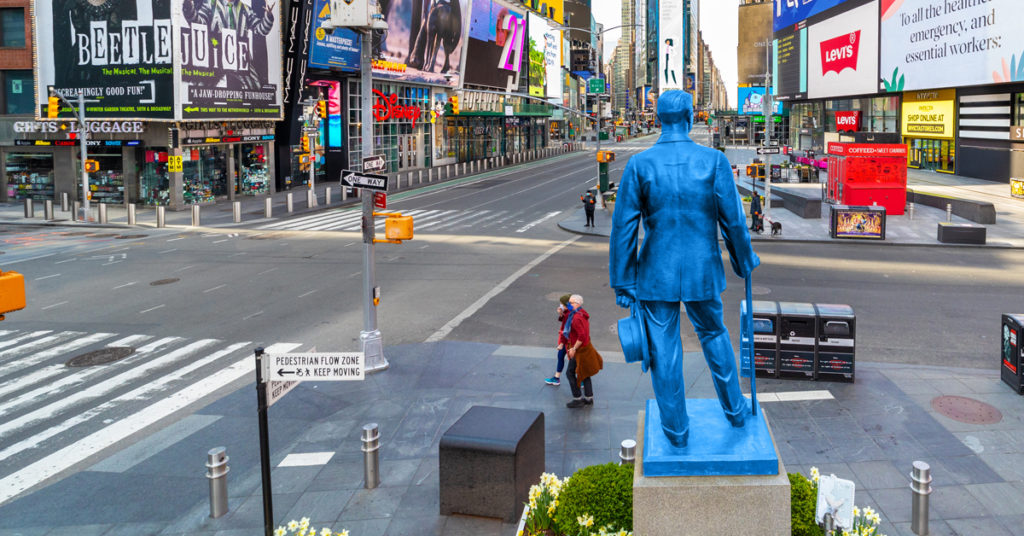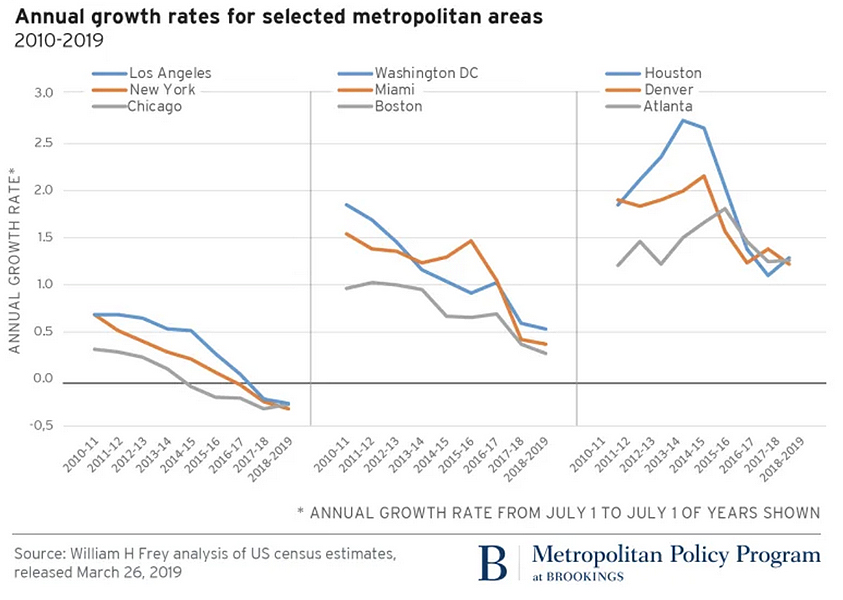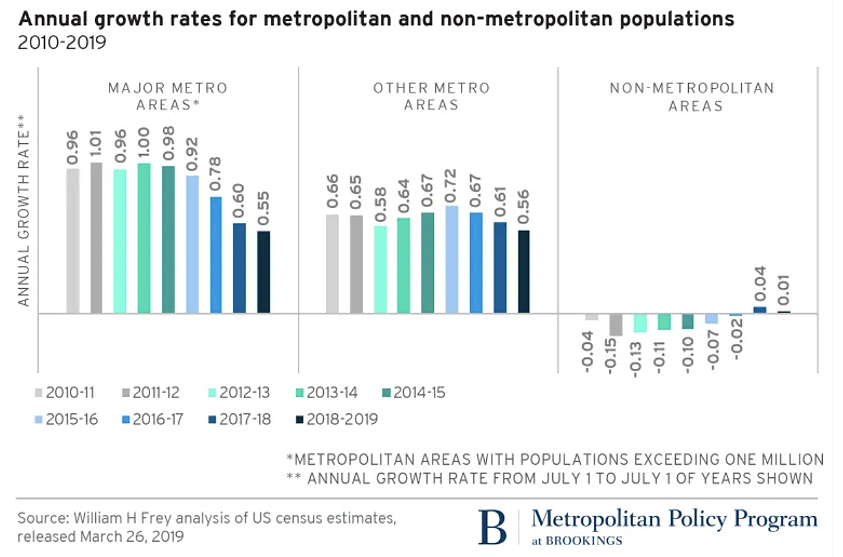Will the Trend Continue?

Since the start of the pandemic, many of the heavily populated metropolitan areas in the U.S. have seen decreases in population, in favor of either smaller metro areas or nonmetropolitan areas (rural and farming communities). The reasons for this migration are pretty clear – people avoiding social settings, fear of a long lockdown, and many others – but we at Propy have been trying to understand if this trend is just that – a short-lived trend – or if it signifies a more permanent change in the population and domestic migration landscape of America.
Upon closer look, we see that this “trend” has been going on since well before COVID struck in January of 2020 and before much of the country went into lockdown 2 months later. The 3 largest metropolitan areas of the US – New York, Chicago, and Los Angeles – all saw declines in their populations dating back as early as 2014 (In the case of Chicago). In fact, the populations of all 3 of these metro areas saw year-over-year slowing of growth from 2010. This chart, provided by the Brookings Institute, shows that, for these 3 major metropolitan areas, the entire decade was one of either decreased growth or, as indicated in the latter half of the decade, one of negative growth.

We can say the same thing for almost all of the 25 main metropolitan areas of the country: flat to negative growth. While they may not have experienced declines in population, they experienced a significant slowing of population growth. This holds true for metro areas Miami, Washington D.C., Boston, Denver, Atlanta, and Houston. Again, the same can be said for almost all of the 25 largest matros. A few cities saw the opposite, and grew substantially. The San Francisco Bay Area and Seattle-Bellevue metros are the most notable examples. Those 2 metros aside, it appears that the table had already been set for a few years, and urban flight had been occurring quietly, while no one was really paying attention. COVID appears to just be the straw that broke the camel’s back and the thing that really got people’s attention.

Is this trend going to continue? Are cities going to see a continuation of flight? At Propy, our goal is to help real estate brokerages, agents, transaction coordinators, and title/escrow companies make good decisions by way of their transaction management platform, but we also want to help them forecast how things will look going forward, so that they can best prepare for their futures.
First of all, it’s important to admit that we don’t know for certain. No one knows. But, we’ve studied this issue, and think that we are poised for a significant slowing down of the slowing down. Said another way, urban populations will stop seeing such a high velocity of departures, and will begin to see mild to moderate growth in their overall populations, starting towards the end of 2021, and continuing for the majority of this decade. This bodes well for cities.
Here is our reasoning:
1. A mid-year economic slow down means that companies will call their people back in
Yes, some popular tech companies have announced that they will permanently allow their employees to work from elsewhere, and because most tech companies are located in large metro areas, the need for employees to live in those cities will be obviated. This is the thinking, and certainly, companies like Twitter, Facebook, and Salesforce instituting a “work-from-anywhere” policy doesn’t bode well for cities. But, most companies are not Twitter, Facebook, and Salesforce. More importantly,, if the year goes as many economists think it will, we are in for a mid-year slow down, and so we think many (not all, of course) companies will call their employees back into their offices. There is no substitution for face-to-face communication and in-person work to raise productivity and profits.
2. Displaced city dwellers remember how much they miss cities
People don’t only live in cities because of work. Most people live in them because they love city life. A recent article in the New York Times showed that people who had moved out of metro areas when COVID came were already tired of “country” life a short few months later, and eager to get back to city life. So, when the vaccine reaches enough people and the U.S. hits mass immunity, we expect a reversal from non-metro areas back to the metros
3. A relaxation of federal Immigration policies
From 2016-2020, the US saw a sharp decline in legal immigration because of enactment of then-new federal policies that barred people from moving to the US. In fact, the issuance of green cards and permanent residency status to college-educated immigrants dropped more than 20% during this 4-year span. With a new Presidential administration, there will certainly be an easing of restrictions on immigration to the US, and with it, an increase in the flow of these newly-minted US residents to US cities, which have historically been the places immigrants are most likely to call their new home.
4. Municipal and State governments in high-tax states see the writing on the wall
Local municipal governments saw that their populations, on the whole, were flattening or even declining starting around 2016, and that it carried throughout the entire decade. COVID, of course, sped up that decline immensely. Why, though, had urban growth already been going down before COVID? Primarily because of cost-of-living and state tax rates. Texas, Nevada, and other low- or no-tax states have been an immense draw to both companies and residents seeking to cut their tax bills. This flight, obviously, results in lower tax receipts for the cities that those companies and people leave. Indeed, not at all good thing for those cities.
At Propy, we think that COVID is the final catalyst, and has finally woken these high-taxing governments up. With such a large increase in urban flight from states like California (San Francisco, Los Angeles) to more affordable ones like Texas (Austin) and North Carolina (Raleigh, Durham, Asheville), these governments are seeing their tax bases shrink as highly educated, high-earning people leave.
Mayors and other leaders of large cities like these have always enjoyed the knowledge that no matter how expensive their cities got, people would stick around. They have learned the hard way that that is just simply not true. People will, in fact, move when push comes to shove. And COVID has been a huge shove. Civic leaders now see that, if they are going to hold on to their tax bases, they are going to have to create more financial incentives for companies and people to stay. Similarly, they are going to have to invest in beautification and restoration projects if they want to keep people around. COVID has taught them a very painful lesson, and we think that they are going to heed it. Say what you want about politicians, but they usually aren’t just plain stupid.
All in all, we think that urban flight will not continue for much longer. We think that by late 2021, we’ll see a gradual and continuous shift back to the cities.
At Propy, we think that 2021 -2022 will be remembered as the beginning of the Great American Urban Renaissance. Urban housing in the beginning of 2021 is at 2015 prices, so opportunities are rife. Add to that that this will be (we think) the year that cities start to become even more enticing, vibrant, and safe. That will take some time, of course, but civic leaders have every single incentive to make sure that it happens – 10 years of slowed or negative growth exacerbated by a pandemic have given them a real kick in the butt.
So, at Propy, we think that 2021 will be a wonderful year for brokers and agents throughout all American cities to give clients with urban aspirations the ability to make their dreams come true.






